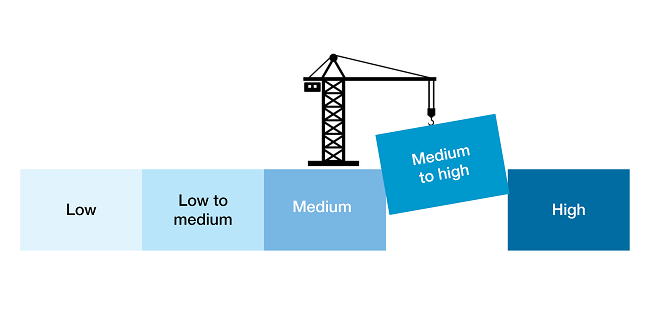
by Tom Bradley
All mutual funds and ETFs (exchange traded funds) have a risk rating attached. It’s meant to give investors a rough idea of what to expect so they can buy a fund, and ultimately build a portfolio, that is suitable for their situation.
At Steadyhand, our ratings range from ‘Low’ (Savings Fund) to ‘Medium to high’ (all our equity funds).
Risk ratings used to be determined by the fund company, but in 2017 the Canadian Securities Administrators (CSA) put in place a formula. The minimum risk rating is now based on a statistical measure — the volatility of the fund over the last ten years. For example, a fund with a 10-year standard deviation (annualized) between 11% and 16% can not be rated below ‘Medium’. For a fund with volatility between 16% and 20%, the minimum is ‘Medium to high’.
In recent months, there’s been a wave of press releases from fund companies announcing they’re reducing the risk rating on many of their funds. You might wonder what is going on given that the investment landscape doesn’t feel any less risky. Well, it’s driven by the formula. With the financial crisis of 2008 and early 2009 no longer in the 10-year calculation, the volatility of many funds has come down, allowing the sponsor to reduce the rating.
In the Report on Business last week, Tim Shufelt wrote about this trend (note: the article is only available to online Globe and Mail subscribers) and suggested that the revised ratings may be misleading. Without a bear market in the numbers, the funds appear to be less risky than they really are. He quotes Dan Hallett of HighView Financial Group as saying, “It’s like the financial crisis never happened.”
In contributing to Tim’s article, I told him about balanced funds (similar in makeup to our Founders Fund) that now have a ‘Low’ rating. As I so eloquently put it, this “doesn’t pass the smell test.”
But fund firms don’t have to be driven strictly by the numbers. At Steadyhand, our funds qualify for lower ratings, but we’ve left them unchanged. For example, the Founders Fund is rated ‘Medium’ risk, even though the volatility calculation would put it comfortably in the ‘Low to Medium’ category.
Why you ask? First of all, we don’t think the markets are any less risky. Second, the fund’s investment approach hasn’t changed. And third, to our way of thinking, a balanced fund (60% stocks / 40% fixed income) should be in the middle of the risk spectrum.
In determining what funds to own, risk ratings should be a small part of the analysis. It’s probably wise, however, to take the suggested level of volatility with a grain of salt.
1We're not a bank.
Which means we don't have to communicate like one (phew!). Sign up for our blog to get the straight goods on investing.

